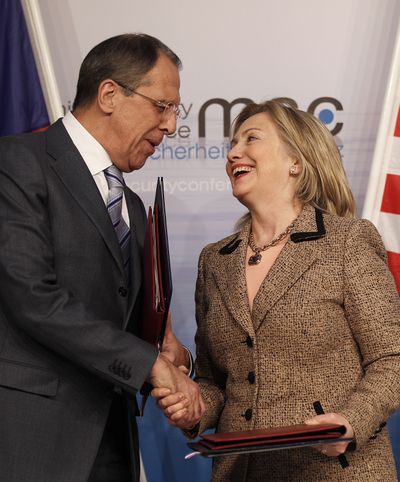New U.S.-Russia arms treaty goes into effect
Ceremony held in Munich, Germany

MUNICH – A new U.S.-Russia nuclear arms control treaty went into effect Saturday, securing a key foreign policy goal of President Barack Obama and raising hopes among officials on both sides that it will provide the impetus for Moscow and Washington to negotiate further reductions.
“The treaty marks significant progress toward President Obama’s vision of a world without nuclear weapons,” U.S. Secretary of State Hillary Rodham Clinton said after exchanging ratification papers with Russian Foreign Minister Sergey Lavrov on the sidelines of an international security conference in Munich.
“Partnership with Russia is vital to our continued progress and to all that we hope to accomplish,” she said. “We must build the habits of cooperation that let us rise above our differences to address urgent matters of global security together.”
The New START treaty – the first major revamping of nuclear disarmament deals since the late Cold War era – was approved by the U.S. Senate in December after a bruising fight during which Obama pressed strongly for its passage. Russia ratified the deal last month.
Russia’s Deputy Prime Minister Sergei Ivanov suggested that the two countries could build upon the new treaty in other areas, saying that “coordinated efforts” were needed in missile defense, and that Moscow also was willing to talk about tactical nuclear weapon reductions.
“We are ready to discuss this very complex topic in the framework of a comprehensive approach to strategic stability,” he said.
The 10-year New START treaty, which can be extended by another five years, is a cornerstone of Obama’s efforts to “reset” U.S. relations with Russia, and Clinton called it a “milestone in our strategic partnership.”
The treaty builds on the original START, or Strategic Arms Reduction Treaty, initially proposed by then-U.S. President Ronald Reagan, which went into effect in 1994. The conclusion of the New START treaty comes the day before the 100th anniversary of Reagan’s birth.
New START, negotiated last year, limits each side to 1,550 strategic warheads, down from 2,200. It limits the number of deployed strategic launchers and heavy bombers to 700.
The pact also re-establishes a monitoring system that ended in December 2009 with the expiration of an earlier arms deal. Russia and the U.S. have the right to conduct onsite inspections beginning 60 days from the agreement going into effect Saturday.
The two countries have seven years to meet the treaty’s central limits.